Chapter 2
Where To Ride on the Road
We’ve all seen bicyclists who wander from left side to right, who go from the sidewalk to the street and who weave in and out between parked cars. From moment to moment, nobody can tell what these bicyclists are about to do. Pedestrians jump back, and car brakes squeal as such bicyclists approach.
On the other hand, we’ve seen bicyclists who seem to blend into the traffic flow smoothly and effortlessly. You always know where they are headed and what to do around them, whether you’re on a bicycle, in a car or on foot. They make bicycling look easy – but aren’t they taking a risk? Isn’t it safer to avoid the traffic as much as possible?
Part of the Traffic Pattern
With very few exceptions, the safest way to ride is as part of the traffic, going with the flow of the normal traffic pattern. Bicyclists who ride this way get where they’re going faster and, according to scientific crash studies, have about five times fewer crashes than bicyclists who make up their own rules (J. Forester; Effective Cycling. Cambridge, MA, MIT Press, 1994).
Generally, the more you follow the normal traffic pattern, the safer and more predictable you become. The rules of the road set up a pattern for every situation, telling which driver may go and which one must wait. With very few exceptions, bicyclists have the same rights – and responsibilities – as motorists. Sometimes you have to wait for other drivers – for example, at a stop sign – but sometimes they have to wait for you.
In this way, the rules of the road protect you by making it clear what you’re going to do next.
If you ride in violation of the traffic laws, you greatly increase your risk of a crash. You also may give up your rights to compensation for your injuries. If you get into a crash this way, the courts will almost always find that it was your fault!
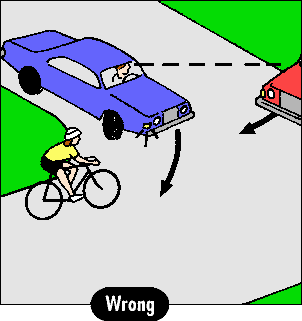
Intersection collisions are the most common type caused by wrong-way riding. The motorist in the side street is looking left, where the traffic normally comes from.
Riding right begins with riding on the right. Then you are where other road users will look for you, and you can ride predictably.
Some cyclists fear being struck from behind and think they’re safer on the left. But rear-end collisions are actually rare, and riding on the left is one of the biggest causes of car-bike crashes. If you ride on the left, drivers and pedestrians about to pull out from side streets and crosswalks will be looking away from you – in the direction traffic normally comes from. As a result, collisions at driveways and intersections are a major hazard for wrong-way riders.
Where is the Road Edge?
Normally, slower traffic keeps to the right, and faster traffic passes on the left. Since your bicycle is usually slower than other traffic, you usually ride near the right edge of the road. But how far to the right?
Generally, the usable width of the road begins where you can ride without increased danger of falls, jolts or blowouts. A road may have a gravel shoulder, its edge may be covered with sand or trash or the pavement may be broken. Don’t ride there. Closer to the center, there’s better pavement, which is swept clean of sand and debris by the passing cars. The usable road width begins here.
Most bicycle crashes are simple falls or are caused by hazards in front of you. Train your eyes to scan the scene ahead, and be wary of blindspots. Keep your eyes moving – you have to look up at the traffic and also down at the road for potholes and cracks. You may sometimes need to slow down in order to spot hazards in time.
Ride far enough into the lane to avoid the risk from blindspots. If you ride too close to parked cars on your right you can’t see around them into side streets and driveways. A pedestrian, car or bicycle could come out from between the parked cars. Drivers in side streets might nose their cars out in front of you to look right and left. And the door of a parked car could open in front of you.
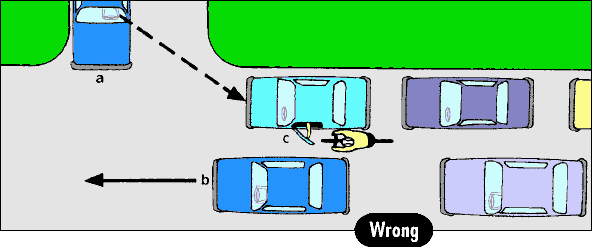
By riding a safe distance from roadside hazards, you increase your safety. When you ride correctly, the motorist in the driveway (a) sees you; the motorist overtaking you (b)... ...will not take the easy way out and skim by your elbow; and the car door (c) is no threat.
Where there are parked cars, the usable width of the street begins about 4 feet out from them – or from a wall, hedge or other obstruction. As you approach a blind intersection or driveway, you should be even farther from the edge of the road – imagine a car hood poking out. Don’t ride in the danger zone! Only if you are riding very slowly – less than 5 miles per hour – can you safely ride within reach of the car doors; even then you must be attentive to opening doors and your reduced visibility to cross traffic. Keep even farther from angle-parked vehicles, which can back out into your path.
Sure, many people – even some bicycling “experts” – will tell you, “Always keep as far to the right as possible,” and, “Look out for opening car doors.” But at speeds above 5 miles per hour, you can’t stop in time to avoid a car door. Then your only choices are to hit the door or to swerve out into the street – maybe into the path of a passing car. Avoid this danger by riding outside the reach of car doors.

Don’t weave between parked cars, where you become invisible to overtaking drivers and must repeatedly re-enter the traffic flow.
Don’t weave in and out between parked cars. If you weave to the right, a parked car will hide you from drivers approaching from behind. Then you have to pop back out into the path of overtaking traffic when you reach the next parked car. Put yourself in the place of a driver a couple of hundred feet behind you. Could this driver see you?
It’s much safer to ride in a predictable, straight line, where everyone can see you. Motorists don’t mind slowing down for a predictable, visible bicyclist nearly as much as they mind a bicyclist who swerves out in front of them.
Extra-wide Lanes
If the road has a paved shoulder or an extra-wide right lane, don’t ride all the way over at the right edge. Instead, keep riding in a straight line 3 or 4 feet to the right of the cars. Stay at a steady distance from the left side of the right lane.
If you stay all the way over at the right edge in an extra-wide lane, you give up your escape zone to the right, and you’re also much more likely to be cut off by a right-turning car. By the time you see the car, it will be blocking your path. If you’re closer to the car, you can turn with it and avoid a crash.
There are two important exceptions to this rule: When you are just past a sharp hillcrest, motorists behind you cannot see you, so it is best to keep to the right until you have picked up some speed. In several U.S. states, it’s legal for bicyclists to ride on some high-speed limited-access highways. Here, you can ride at the right side of the shoulder, avoiding the wind blast from big trucks. Except at the rare on- and off-ramps, limited-access highways have no cross traffic, so there’s no problem with turning cars or pedestrians.
Narrow Lanes
In a wide lane, there’s room for cars to pass you. But in a narrow lane, motorists have to move partly or entirely into the next lane to pass you. Narrow lanes are common on city streets and on back roads in the country. On a narrow two-lane, two-way rural road, stay alert to strings of oncoming vehicles in the opposite lane, in case one pulls into your lane to pass. You can ride nearer the edge of this type of road if motorists are coming from only one direction at a time. Then cars from the rear can pass you without having to move as far into the other lane.
But if motorists are coming from both directions, you have to take control of the situation. You can’t take chances that the drivers behind you will try to pass you despite oncoming traffic.
When a vehicle is approaching from the front, glance to the rear, and if there’s traffic there too, take the first opportunity to merge safely to the middle of the right lane. Also merge to the middle of a narrow right lane at a blind curve where there might be oncoming traffic. On a right curve, this technique also makes you visible earlier to the drivers behind you.
The driver behind you will have to slow and follow you. It helps to make a “slow” signal (left arm extended downward) to indicate that you’re aware of the car behind you and that it’s unsafe to pass. Don’t let an impatient driver cause a crash.
Understand that the law is on your side. The law gives you the right to use the road, the same as a motorist, and requires other traffic slow down for you sometimes. A driver approaching from the rear is always required to slow and follow if it’s not possible to pass safely.
It may seem dangerous to make a motorist slow for you, but it’s not. The usual reason that bicyclists feel unsafe on narrow roads is that they do not take control of the situation when drivers behind them don’t have room to pass safely. If you ride all the way to the right, you’re inviting motorists to pass you when it is unsafe and, too often, they will. If you show clearly that it’s not safe for drivers to pass you, they’re unlikely to try.
But be courteous. When it becomes safe for the car behind you to pass, move to the right and give the driver a friendly wave. If you block traffic for more than a short time, common courtesy suggests, and the law normally requires, that you pull to the side and let the traffic by when you can safely do so.
On a road with two or more narrow lanes in your direction – like many city streets – you should ride in the middle of the right lane at all times. You need to send the message to drivers to move to the passing lane to pass you. If you ride all the way to the right, two cars may pass you at the same time, side by side, giving you too little clearance for safety.
Bike Lanes
A well-designed bike lane should encourage you to ride in the correct position on the road when you go slower than the cars. It should also encourage you to move left, out of the bike lane, before an intersection if you are going straight or turning left. Don’t be lulled into riding in the danger zone close to parked cars; you often need to ride along a bike lane’s left edge. Remember that motorists will cross the bike lane to park and pull in and out of driveways. Pass on the left whenever possible. If local laws permit passing on the right, do so only very slowly and where a car could not possibly turn right. You may be in a motorist’s blind spot; a car door could open, or a pedestrian could be jaywalking between the cars. Never pass a long truck or bus on the right. Remember: don’t hesitate to leave the bike lane when necessary for your safety – all the guidelines about lane position in this book apply whether or not there is a bike lane.
When You Go Faster Than Cars
Usually, motor vehicles travel faster than bicycles, but not always. A row of cars may have slowed in a traffic jam. Or you may be riding down a hill where you can keep up with the motorists.
If you’re going as fast as the cars, pull into line with them. When riding down a hill at high speed, you need more room to steer and brake. Besides, it’s dangerous to ride along next to the right side of a car. The driver could turn right or edge closer to the curb without ever seeing you. The safest position in traffic doesn’t depend on whether you’re riding a bicycle or driving a car. It depends on how fast you’re going and where you’re headed.

When going as fast as the cars, you’re much safer in the middle of the traffic lane where the driver behind you can see you.
As long as you keep up with the car in front of you, stay in line with it. If you begin to fall behind, pull to the right. But if you’re traveling faster than the car, pass on the left, just as if you were driving a car yourself. Drivers expect to be passed on the left, so they look back to the left before they pull out.
Before you pass, look back for traffic to make sure that you can pull safely into the passing lane. Keep your distance from the side of the car you’re passing. Don’t sneak along next to it. Put yourself where the driver will look for you. If you’re passing a long truck or bus, give it even more clearance – at least 5 or 6 feet – since it could move farther before you could get out of its way. When you’re finished passing, move back into the right lane.
Sometimes the car, bus or truck you’re passing will pick up speed while you’re still next to it. Then just keep the same position in the lane, and brake lightly if necessary to fall back. When you’ve fallen behind, look back to the right for traffic, then merge back to your normal position in the right lane.
On a street with multiple right-turn lanes or heavy, slow traffic, you may move left more than one lane to pass slower traffic.
Multi-use Paths
Sometimes you have a choice between riding on a road and a multi-use path. A path might provide a useful shortcut, and it can be pleasant and scenic, but many paths are no place for a high-speed training or fast commuting ride. Intersections may be frequent and there can be confusion as to who must yield right of way. A path may be narrow, have blind corners, and be crowded with unpredictable inline skaters, dog walkers and inexperienced bicyclists.
Ride at a reasonable speed; more slowly when it is crowded. Take extra care at intersections. Move off the path if you stop riding. When overtaking give an audible signal and leave plenty of space if you can – the closer you must pass the more slowly you must go. Remember that pedestrians can change direction suddenly. A path does not automatically make you safe – you still must be alert for many potential hazards!
Summary
Many cyclists believe they are safer and more comfortable riding further to the right than this booklet recommends. They fear being passed uncomfortably close by a motorist, or feel intimidated by impatient drivers. Riding too far to the right is very dangerous for several reasons. It puts the cyclist in the danger zone of poor sightlines and opening car doors; it invites motorists to pass too closely; and it takes away the cyclist’s escape route to the right in the event of the unexpected. The correct lane positions described in this booklet are the safest and most efficient. Do not be intimidated. Take responsibility for your own safety, even if other traffic must occasionally slow and follow you.
Your correct position on the road follows a sensible set of rules, the same as for a car driver: keep to the right if you’re going slowly, but pull to the left to pass. The way you carry out these rules is a little different – as explained here – since your bicycle is narrow and usually slow.
An understanding of road positioning makes the difference between the rider who weaves and wanders and the one who blends smoothly and safely into the traffic flow.

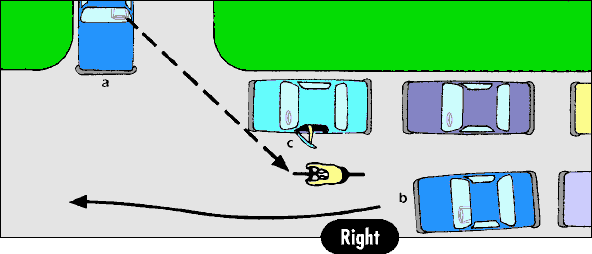
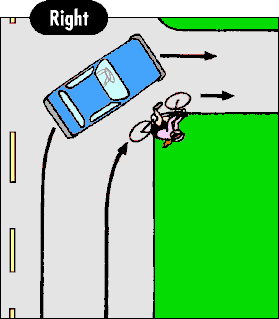
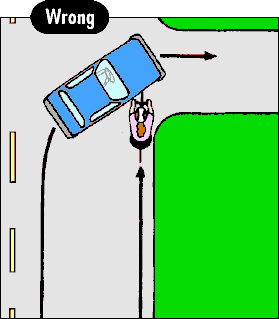

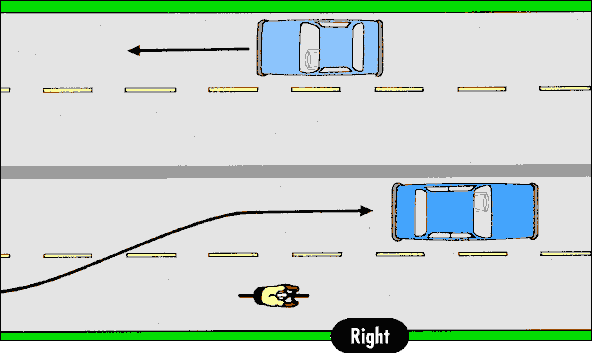

Illustrations with “Right” and “Wrong” are downsized ones for Web use and have integral borderlines. Displaying these illustrations at full size avoids WordPress’s resizing process, which turns transparent areas (which allow the “Right” and “wrong” lozenges to go outside the border) black.
First paragraph is quite different in the LHD version, because erratic cycling is less common in the U.K. it reads: “We’ve all seen cyclists who are timid and fearful in traffic, who prefer to ride only on cycle paths.”
Paragraph on wrong-way riding is very different in the LHD and German versions, because wrong-way riding is less common there but sidepaths are common. It reads: “In some countries, bikeways are placed alongside the roads like sidewalks, or on the sidewalk; in the worst cases, they are for two-way traffic. It is dangerous enough to use this kind of bikeway when riding in the direction of traffic in the nearest lane, as turning motorists may not see you approaching from behind. It is even more dangerous to ride opposite the direction of traffic. A motorist entering from a side street normally does not constantly look left, not expecting fast traffic from that direction. The driver expects and must pay attention only to slow pedestrian traffic.”
Another bike path hazard worth mentioning is the path’s pavement edge. I know several club members who have crashed by momentarily leaving the pavement then trying to steer back on, where the pavement edge prevented balancing.